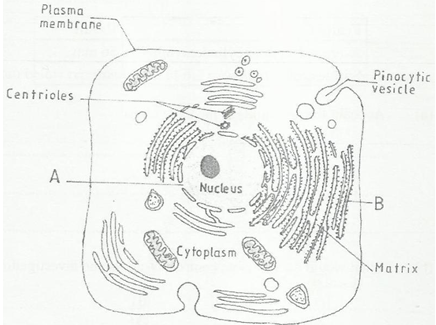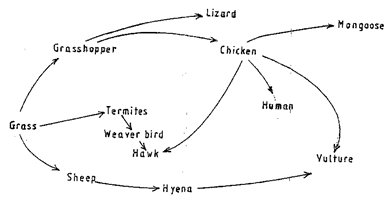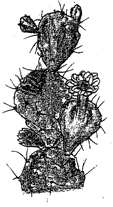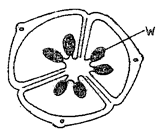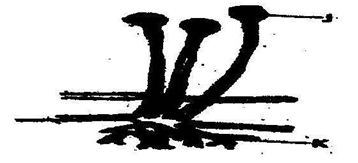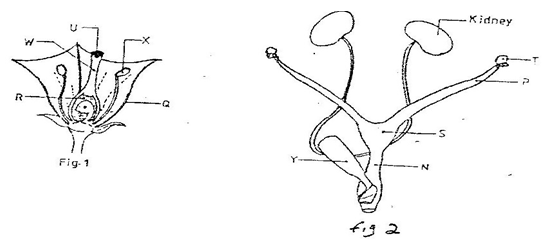INSTRUCTIONS TO CANDIDATES
- Answer ALL the questions in the spaces provided

QUESTIONS
-
- State two characteristics that are specific to plants (2mks)
- Name three mechanisms that ensure cross pollination takes place in flowering plants. (3mks)
-
- State two differences between complete and incomplete metamorphosis. (2mks)
- State the importance of moulting to an insect. (2mks)
- A student collected an organism and observed the following features: simple eyes, four pairs of legs and two body parts.
- State the class to which the organism belongs. (1 mark)
- Give an example of an organism in this class. (1 mark)
- Name the kingdom to which plasmodium belongs (1 mark)
- Name the three end products of anaerobic respiration in plants. (3 marks)
- State two reasons why accumulation of lactic acid leads to an increase in heart beat. (2 marks)
- Name the flower parts that produces gametes. (2 marks)
- What is meant by the following terms? (2 marks)
- Ecology
- Carrying capacity
- How is the human sperm cell structurally adapted? (2 marks)
- The figure below is a fine structure of a generalized animal cell as seen under an electron microscope.
- Name the parts labeled A and B. (2 marks)
A………………………………………………………………………
B……………………………………………………………………… - How is the structure labeled B adapted to its function? (2 marks)
- Name the parts labeled A and B. (2 marks)
- What name is given to a group of hormones that controls the development of secondary sexual characteristics in a human male? (1 mark)
- Name two substances that leave the foetal blood through the placenta (2 marks)
- Name two nutrients that are absorbed without being digested by enzymes in humans.(2 marks)
- State one use for each of the following apparatus in the study of living organisms. (2 marks)
- Pooter
- Pitfall trap
- The figure below illustrates a food web in a certain ecosystem.
From the food web:- Draw the shortest food chain; (2 marks)
- Identify the organisms with the highest
- Number of predators (1 mark)
- Biomass (1 mark)
- State two functions of the following parts of a light microscope.
- Fine adjustment knob (2 marks)
- Stage (2 marks)
- The diagram below represents a certain plant.
- What is the likely habitant of the plant? (1 mark)
- Give two reasons for your answer in (a) above. (2 marks)
- The number of stomata on the lower and upper surface of two leaves from plant X and Y were counted under the field of view of a light microscope. The results were as shown in the table below.
Leaf Number of stomata Upper surface Lower surface X 4 12 Y 20 23 - Which of the leaves would be expected to have a lower rate of transpiration? (1 mark)
- Given a reason for your answer in (a) above (2 marks)
- The diagram below represents a transverse section of an ovary from a certain flower.
-
- Name the structure labeled W (1 mark)
- Name the type of placentation illustrated in this diagram. (1 mark)
- Give an example of a fruit that show the type of placentation illustrated in this diagram. (1 mark)
-
- The diagram below illustrates the structure of bread mould.
- Name the part labeled J (1 mark)
- State the function of the structure labeled K (2 marks)
- What is meant by the following term?
- Habitat; (1 mark)
- Ecosystem (1 mark)
- State two ways by which acquired Immune deficiency syndrome (A.I.D.S) Virus is transmitted. ( 2 mks)
- Figures 1 and 2 below represent reproductive organ of plants and an animal respectively.
- Which letters in figures 1 and 2 represents the organs that produce female gametes? (2mks)
Figure 1…………………………………………….
Figure 2………………………………………………… - What is the function of the structure labeled S? (2mks)
- Name the structure labeled W (1mk)
- Which letters in figures 1 and 2 represents the structures where fertilization takes place (2mks)
- Which letter in figure 1 represents the structure where male gametes are produced (1mk)
- Which letters in figures 1 and 2 represents the organs that produce female gametes? (2mks)
- What is the function of the following structures in the human reproductive organ?
- Fallopian tubes. (2 mark)
- Epididymis (1 mark)
- Scrotal sac (2 mark)
- State any three fruit and seed dispersal mechanisms (3mks)
- A student observing a leg of an insect under a hand lens made a drawing of the leg whose length was 4cm a width magnification of X2.what was the actual length of the leg? (3mks)
- Give two reasons why mitosis is important to organisms. (2mks)

MARKING SCHEME
-
- Autotrophic nutrition; show alternation of generation; Limited movement; Limited excretory products/unspecialized respiratory structures; Localized growth;
- having brightly coloured flowers; scented flowers; protandry;protagyny;self sterility; heterostyly;
-
- Complete metamorphosis - eggs hatch into larvae while in incomplete metamorphosis hatch into nymphs which resemble the adult;
Complete metamorphosis has four stages; egg, larvae, pupa and adult while in incomplete metamorphosis has three stages; egg, nymph and adult. - To allow for growth of the insect;
- Complete metamorphosis - eggs hatch into larvae while in incomplete metamorphosis hatch into nymphs which resemble the adult;
-
- Arachnida;
- Spider/scorpion/tick/mite;
- Protoctista /protista;
- Alcohol/ethanol; Carbon (IV) oxide; Energy/Adenosine Triphosphate;
- -To increase supply of oxygen to the tissues;
-The oxygen is used to oxidize lactic acid (to carbon (IV) oxide, water and energy); - Ovary /Anther;
-
- This is the study of the interrelationship between organisms and their environment
- The maximum population of a species/Total number of organisms that a population habitat/area/region/ecosystem can support or Total number of population of a species a given habitat/area/region/ ecosystem can support without depleting available resources. Rej. If different species
- Acrosome /Lysosome contain enzyme to digest membrane of the ovum;
- Numerous mitochondria to provide energy for movement;
- Long tail for faster movement; -
- A nuclear pore
B Rough endoplasmic reticulum - Surface area covered with ribosome’s; for protein synthesis/ channels for transport of protein
- A nuclear pore
- Androgens
Acc-androgen - Carbon (IV) oxide, nitrogenous waste
- water; mineral ions/salts, vitamins
-
- Sacking small insects/small animals
- A trap into which (small) animals fall and get trapped; acc. Examples of small animals e.g. insect/reptiles. Arachnids
-
- Grass → Grasshopper → Lizards
-
- Chicken
- Grass
-
- Fine adjustment knob
Moves the body tube through smaller distances to bring image/specimen/object into sharper/sharp focus - Stage
Platform where specimen (on slide) is placed
- Fine adjustment knob
-
- Dry/arid/semi-arid/desert
- Succulent/freshly stem; reduced leaves/leaves reduced into thorns/spines. Acc. Thick stem for storage of water
-
- X
- X has fewer stomata; most stomata in leaf X are concentrated on the lower side
-
-
- Ovule; rej; ovules
- Axile
- Orange or any other citrus fruit; lemon, tangerine, grape, lime, tomato, Sodom apple, Irish potato, egg plant, thorn apple, banana
-
-
- J – sporangium
- - Absorption of soluble substances/ digested food
- Secretion of digestive enzymes;
- Anchorage(of mould on substrate); anchorage must be in the right context
-
- Place/environment in which (specified)organism lives
- A natural unit with abiotic and biotic factors
- Aids causes
- Sexual intercourse
- Blood transfusion
- Pregnant HIV positive mother to child
-
- Figure 1 R:
Figure 2 T: Accept growth - Development of the foetus /zygote/fertilized/ova/egg/embryo
- Style
- R;P;
- X
- Figure 1 R:
-
- Passage of ova/ site of fertilization
- Storage of sperms
- Hold the testis/ protect the testis
- Explosive; water; wind; animal
- Actual length= drawing length divided by magnification;
4/2=2cm; - Leads to growth of the organism;
-Production of new cells;
Join our whatsapp group for latest updates
Tap Here to Download for 50/-
Get on WhatsApp for 50/-
Download Biology Paper 1 Questions and Answers - Form 3 Term 3 Opener Exams 2021.
Tap Here to Download for 50/-
Get on WhatsApp for 50/-
Why download?
- ✔ To read offline at any time.
- ✔ To Print at your convenience
- ✔ Share Easily with Friends / Students

